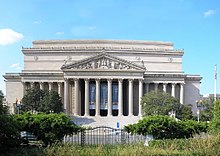National Archives and Records Administration
![]()
This article explains the US National Archives; the UK National Archives is explained at The National Archives.
![]()
This article or subsequent section is not sufficiently supported by evidence (e.g., anecdotal evidence). Information without sufficient evidence may be removed in the near future. Please help Wikipedia by researching the information and adding good supporting evidence.
The National Archives and Records Administration (NARA), located in Washington, D.C., is the National Archives of the United States and is responsible for the protection and preservation of historical and government documents. Another mission is to facilitate public access to these documents. The National Archives is officially responsible for publishing Acts of Congress, Proclamations and Executive Orders of the President, and federal regulations. Headed by The Archivist of the United States, the agency often works with scholars to assist with studies being conducted.
Buildings and exhibitions
Main building
Located just north of the National Mall on Pennsylvania Avenue, halfway between the White House and the Capitol in Washington, D.C., the National Archives building opened as the original headquarters in 1935. It houses original copies of the three most important founding documents of the United States: the Declaration of Independence, the Constitution of the United States, and the Bill of Rights. These documents are on display to the public in the main chamber of the National Archives. The chamber is also known as the Rotunda for the Charters of Freedom.
The main building also displays other important documents from United States history, such as the Louisiana Purchase Treaty and the Emancipation Proclamation, as well as a collection of photographs and other historically and culturally important artifacts.
The building was used as a backdrop for the 2004 film National Treasure starring Nicolas Cage. The staff entrance he used to enter the building is also in fact the entrance for staff and scientists.
National Archives in College Park
Due to space limitations, the National Archives opened a second building in College Park, Maryland in 1994. The National Archives also maintains twelve regional archives throughout the United States and two larger facilities in St. Louis, Missouri, which form the National Personnel Records Center. The main building in Washington, however, continues to hold a large collection of documents, such as the results of all U.S. censuses, passenger lists, military documents from the War of Independence through the Philippine-American War, Confederate government documents, and various land records.
Presidential Libraries
NARA also maintains the Presidential Libraries, a nationwide library network for preserving and accessing all presidential documents since Herbert C. Hoover. These libraries are also open to the public.

Document exhibition in the public exhibition area

The main building of the National Archives in Washington, D.C.
Other
Since 1988, NARA has had an Inspector General responsible for auditing and internal investigations. Paul Brachfeld has held the position since December 20, 1998.
Questions and Answers
Q: What is the National Archives and Records Administration?
A: The National Archives and Records Administration (NARA) is a United States government agency responsible for preserving and documenting government and historical records.
Q: What is NARA's main responsibility with regards to documents?
A: NARA is responsible for maintaining and publishing the original copies of acts of Congress, presidential directives, and federal regulations.
Q: What other role does NARA have in informing the public?
A: NARA informs the public of the votes of the Electoral College to Congress.
Q: Why is it important that NARA retains historical records?
A: NARA retains historical records to preserve them for future generations and to promote accountability and transparency in government.
Q: Can people see the documents in the National Archive?
A: Yes, NARA is in charge of making it easier for people to see the documents which make up the National Archive.
Q: How does NARA make it easier for people to access the National Archive documents?
A: NARA makes it easier for people to see the National Archive documents by providing online access, offering research services, and maintaining physical facilities across the US.
Q: What types of documents does NARA take charge of?
A: NARA takes charge of government and historical records, including acts of Congress, presidential directives, federal regulations, and more.
Search within the encyclopedia